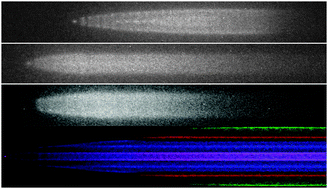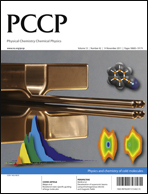In this work we demonstrate vibrational spectroscopy of polyatomic ions that are trapped and sympathetically cooled by laser-cooled atomic ions. We use the protonated dipeptide tryptophan–alanine (HTyrAla+) as a model system, cooled by barium ions to less than 800 mK secular temperature. The spectroscopy is performed on the fundamental vibrational transition of a local vibrational mode at 2.74 μm using a continuous-wave optical parametric oscillator (OPO). Resonant IR multi-photon dissociation spectroscopy (R-IRMPD) (without the use of a UV laser) generates charged molecular fragments, which are sympathetically cooled and trapped, and subsequently released from the trap and counted. We measured the cross section for R-IRMPD under conditions of low intensity, and found it to be approximately two orders smaller than the vibrational excitation cross section. The observed rotational bandwidth of the vibrational transition is larger than the one expected from the combined effects of 300 K black-body temperature, conformer-dependent line shifts, and intermolecular vibrational relaxation broadening (J. Stearns et al., J. Chem. Phys., 2007, 127, 154322–154327). This indicates that as the internal energy of the molecule grows, an increase of the rotational temperature of the molecular ions well above room temperature (up to on the order of 1000 K), and/or an appreciable shift of the vibrational transition frequency (approx. 6–8 cm−1) occurs.

You have access to this article
 Please wait while we load your content...
Something went wrong. Try again?
Please wait while we load your content...
Something went wrong. Try again?


 Please wait while we load your content...
Please wait while we load your content...